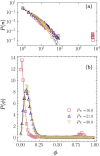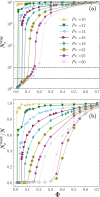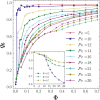The interplay between chemo-phoretic interactions and crowding in active colloids
- PMID: 36857712
- PMCID: PMC10053041
- DOI: 10.1039/d2sm00957a
The interplay between chemo-phoretic interactions and crowding in active colloids
Abstract
Many motile microorganisms communicate with each other and their environments via chemical signaling which leads to long-range interactions mediated by self-generated chemical gradients. However, consequences of the interplay between crowding and chemotactic interactions on their collective behavior remain poorly understood. In this work, we use Brownian dynamics simulations to investigate the effect of packing fraction on the formation of non-equilibrium structures in a monolayer of diffusiophoretic self-propelled colloids as a model for chemically active particles. Focusing on the case when a chemical field induces attractive positional and repulsive orientational interactions, we explore dynamical steady-states of active colloids of varying packing fractions and degrees of motility. In addition to collapsed, active gas, and dynamical clustering steady-states reported earlier for low packing fractions, a new phase-separated state emerges. The phase separation results from a competition between long-range diffusiophoretic interactions and motility and is observed at moderate activities and a wide range of packing fractions. Our analysis suggests that the fraction of particles in the largest cluster is a suitable order parameter for capturing the transition from an active gas and dynamical clustering states to a phase-separated state.
Conflict of interest statement
There are no conflicts to declare.
Figures









References
-
- Ramaswamy S. The mechanics and statistics of active matter. Annu. Rev. Condens. Matter Phys. 2010;1:323–345. doi: 10.1146/annurev-conmatphys-070909-104101. - DOI
-
- Marchetti M. Joanny J. Ramaswamy S. Liverpool T. Porst J. Rao M. Simha R. Hydrodynamics of soft active matter. Rev. Mod. Phys. 2013;85:1143. doi: 10.1103/RevModPhys.85.1143. - DOI
-
- Zöttl A. Stark H. Emergent behavior in active colloids. J. Phys.: Condensed. Matter. 2016;28:253001. doi: 10.1088/0953-8984/28/25/253001. - DOI
-
- Chaté H. Dry Aligning Diluite Active Matter. Annu. Rev. Condens. Mat. 2020;11:189–192. doi: 10.1146/annurev-conmatphys-031119-050752. - DOI
LinkOut - more resources
Full Text Sources

